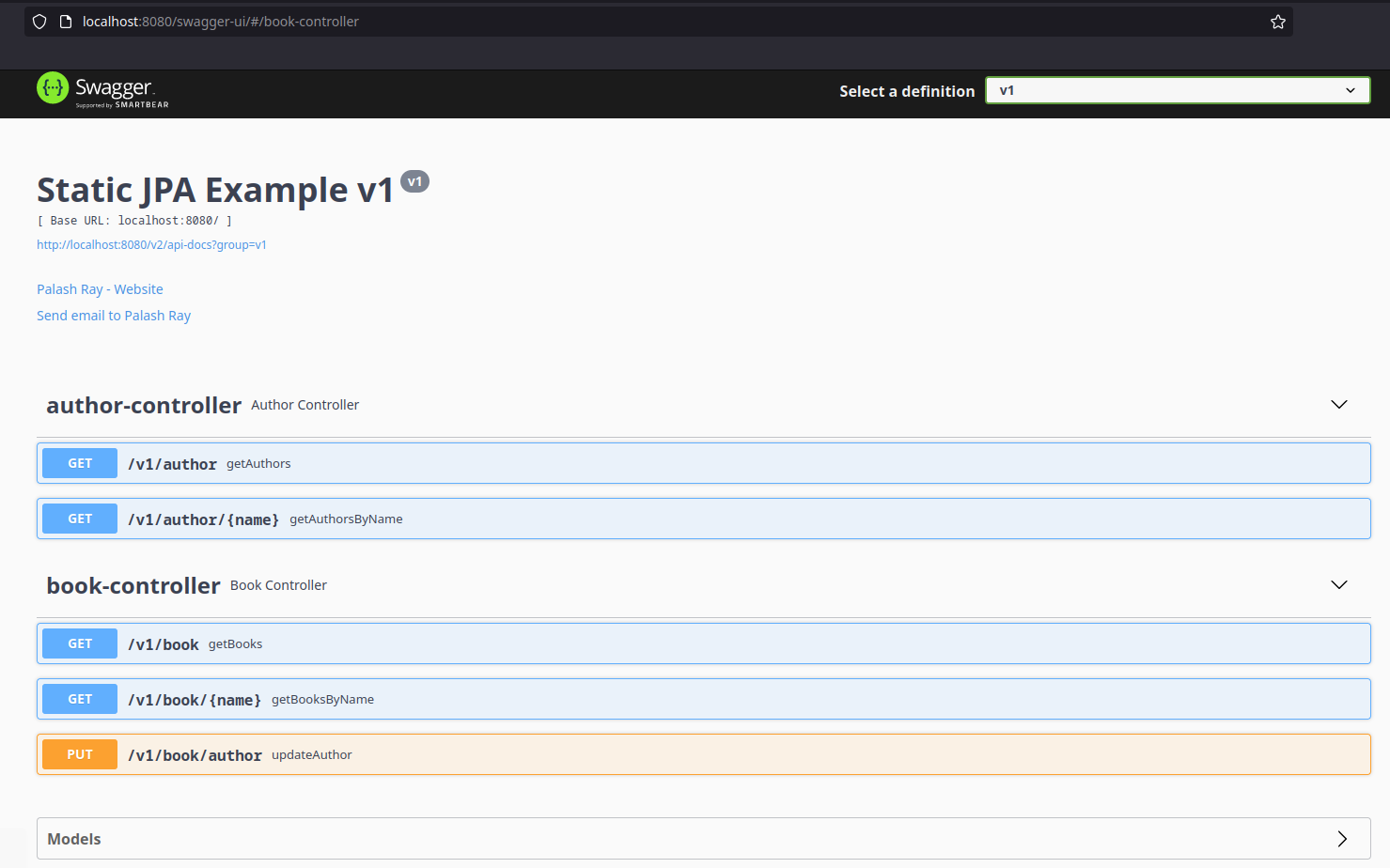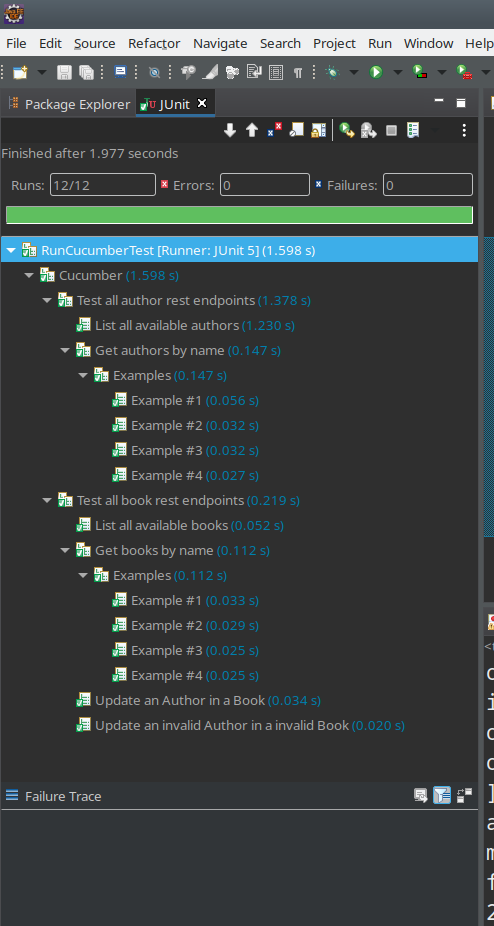Introduction
At the outset, be warned that this is not for the fainthearted. Be prepared for a long and arduous read. Having said that, lets begin.
Many a times, I have wondered, if I can ever create a JPA Entity and a JPA Repository class dynamically, on the fly? Well, its certainly possible, though a bit complicated.
Library REST Service
We will be building a mock library service with Spring Boot and a in-memory H2 Database. There are broadly 2 REST endpoints:
- Author
- Book
Both of these allow us to fetch all items, and also search by partial name. These are GET calls.
On the Book, we have an additional PUT call that allows us the change the Author of a Book.
Start Simple
We will build a very normal JPA based Spring Boot Application. We have called this the static-jpa-repo-simple. It consists of 2 Entities and JPA Repos for Book and Author respectively.
This is the Book entity:
@Entity
@Table(name = "book")
@Data
public class Book {
@Id
@GeneratedValue(strategy = GenerationType.IDENTITY)
private int id;
@Column
private String name;
@OneToOne(fetch = FetchType.EAGER)
@JoinColumn(name = "author_id")
private Author author;
}
And this is the corresponding JPA Repository:
public interface BookDao extends CrudRepository<Book, Integer> {
List<Book> findByNameContainingIgnoreCase(String name);
@Transactional
@Modifying
@Query("update Book set author.id = :authorId where id = :bookId")
int updateAuthor(int bookId, int authorId);
}
The first method findByNameContainingIgnoreCase(), as the name indicates, would do a case-insensitive search on the name of a Book.
The second method updateAuthor() would update an Author in a given Book.
Pretty mundane, I would say. If you browse to the Swagger Page: http://localhost:8080/swagger-ui/, this is how it looks like:

Sources
These sources can be found here: https://github.com/paawak/spring-boot-demo/tree/master/dynamic-jpa/static-jpa-repo-simple
Test Harness
At this point, before we delve any further, we will write a BDD/Cucumber based test harness to test all our REST endpoints. Run the main class such that the Application starts at http://localhost:8080. Then, run the RunCucumberTest. This is very similar to our previous entry: https://palashray.com/example-of-creating-cucumber-based-bdd-tests-using-junit5-and-spring-dependency-injection/. As shown below, ensure all the tests are green.

Making JPA Dynamic
OK, so what exactly are we trying to do? We are trying to generate the JPA Entity Book and the JPA Repository BookDao dynamically using ByteBuddy. Again, very similar to our previous blog post: https://palashray.com/creating-class-dynamically-using-bytebuddy-and-springboot/.
Abstraction
To make this happen, we have to delete both of these classes as the first step. Since many other classes like the Rest Controller depends on these 2 classes, we have to first create an abstraction for these 2.
We will start by copying the static-jpa-repo-simple, and renaming it to static-jpa-repo-abstraction. We will refactor the code to suit our needs.
Abstracting the Entity
For the Entity, we will first create an interface, closely resembling the Book:
public interface BookTemplate {
int getId();
void setId(int id);
String getName();
void setName(String name);
Author getAuthor();
void setAuthor(Author author);
}
We will use this interface in place of Book, like in our Rest layer, the BookController. In the next step, to further simplify our Entity, we will create a MappedSuperClass with all the JPA annotated fields.
@MappedSuperclass
@Data
public class BookTemplateImpl implements BookTemplate {
@Id
@GeneratedValue(strategy = GenerationType.IDENTITY)
private int id;
@Column
private String name;
@OneToOne(fetch = FetchType.EAGER)
@JoinColumn(name = "author_id")
private Author author;
}
Now, our Entity has become very simple, it just needs to extend the BookTemplateImpl and have a few JPA annotations of its own.
@Entity
@Table(name = "book")
public class Book extends BookTemplateImpl {
}
Abstracting the Dao
We will look at the BookDao and create a simple interface that does not extend the CrudRepository, with only the methods that would be used by us.
public interface BookDaoTemplate {
List<BookTemplate> findByNameContainingIgnoreCase(String name);
int updateAuthor(int bookId, int authorId);
Iterable<? extends BookTemplate> findAll();
}
We would be using this in our entire project instead of the BookDao. As a side effect, our BookDao has become simpler:
public interface BookDao extends BookDaoTemplate, CrudRepository<Book, Integer> {
@Override
@Transactional
@Modifying
@Query("update Book set author.id = :authorId where id = :bookId")
int updateAuthor(int bookId, int authorId);
}
Registering the JPA Repository Dynamically
We have pretty much figured out how to generate the Entity and the Repository dynamically. However, once we have generated these classes, how to dynamically register the Repository as a Spring Bean?
The answer lies in configuring a JpaRepositoryFactoryBean. When using Spring Boot, if we do not specify a JpaRepositoryFactoryBean explicitly, the JpaRepositoriesAutoConfiguration kicks in and starts looking for JPA Repositories in the classpath. However, we can use the JpaRepositoryFactoryBean manually and register our JPA Repositories ourselves, as shown below:
@Configuration
public class JpaRepoConfig {
@Bean
public JpaRepositoryFactoryBean<AuthorDao, Author, Integer> authorRepository() {
return new JpaRepositoryFactoryBean<>(AuthorDao.class);
}
@Bean
public JpaRepositoryFactoryBean<BookDao, Book, Integer> bookRepository() {
return new JpaRepositoryFactoryBean<>(BookDao.class);
}
}
Sources
The sources for the static-jpa-repo-abstraction can be found here: https://github.com/paawak/spring-boot-demo/tree/master/dynamic-jpa/static-jpa-repo-abstraction.
Take the plunge
We will copy the code from the static-jpa-repo-abstraction and rename it to dynamic-jpa-repo.
We are finally ready! Lets delete the below classes as a start:
- Book
- BookDao
- JpaRepoConfig
You should not get any compilation error, as these classes are not used by anyone directly.
We will create a helper class DynamicClassGenerator to create the Entity and the Dao class dynamically with ByteBuddy.
Generating the Entity
The below code does the trick:
Unloaded<?> generatedClass = new ByteBuddy().subclass(BookTemplateImpl.class)
.annotateType(AnnotationDescription.Builder.ofType(Entity.class).build(),
AnnotationDescription.Builder.ofType(Table.class).define("name", "book").build())
.name(entityClassName).make();
As is evident, we start by extending the BookTemplateImpl. We then go on to add 2 class level annotation:
- @Entity
- @Table(name = “book”)
Generating the Repository
This is how the Repository can be generated:
Generic crudRepo = Generic.Builder.parameterizedType(CrudRepository.class, entityClass, Integer.class).build();
Unloaded<?> generatedClass = new ByteBuddy().makeInterface(crudRepo).implement(BookDaoTemplate.class)
.method(ElementMatchers.named("updateAuthor")).withoutCode()
.annotateMethod(AnnotationDescription.Builder.ofType(Transactional.class).build())
.annotateMethod(AnnotationDescription.Builder.ofType(Modifying.class).build())
.annotateMethod(AnnotationDescription.Builder.ofType(Query.class)
.define("value",
"update " + entityClass.getSimpleName()
+ " set author.id = :authorId where id = :bookId")
.build())
.name(repositoryClassName).make();
Relax, don’t get intimidated by the above. It is actually quite simple. Let me list down the steps:
- Create the fragment CrudRepository<Book, Integer> with the variable CrudRepository<Book, Integer>
- Start with that, and extend from the BookDaoTemplate
- Define the method updateAuthor
- Define the 3 annotations on this method along with their parameters
Saving the generated classes on disk
Now, this is really the tricky thing. Since Spring JPA needs these classes to be present as .class files on the classpath, it is absolutely necessary to save this on the disk.
Loaded<?> loadedClass = unloadedClass.load(getClass().getClassLoader(), ClassLoadingStrategy.Default.INJECTION);
try {
loadedClass.saveIn(new File("target/classes"));
} catch (IOException e) {
throw new RuntimeException(e);
}
I am saving it in a directory, but you can also save it in a jar file.
Tying it together
We define a class that implements the BeanFactoryPostProcessor.
@Configuration
public class DynamicJpaBeanFactoryPostProcessor implements BeanFactoryPostProcessor {
@Override
public void postProcessBeanFactory(ConfigurableListableBeanFactory beanFactory) {
}
}
This is invoked after Spring Beans are registered. We would generate the classes in the postProcessBeanFactory(). Also, after our classes are created, we would then, as a last step, register our freshly minted JPA Repository as a Spring Bean using the JpaRepositoryFactoryBean.
private void registerJpaRepositoryFactoryBean(Class<?> jpaRepositoryClass,
DefaultListableBeanFactory defaultListableBeanFactory) {
String beanName = jpaRepositoryClass.getSimpleName();
BeanDefinitionBuilder beanDefinitionBuilder = BeanDefinitionBuilder
.rootBeanDefinition(JpaRepositoryFactoryBean.class).addConstructorArgValue(jpaRepositoryClass);
defaultListableBeanFactory.registerBeanDefinition(beanName, beanDefinitionBuilder.getBeanDefinition());
}
This above code is basically just mimicking the below code dynamically:
@Bean
public JpaRepositoryFactoryBean<BookDao, Book, Integer> bookRepository() {
return new JpaRepositoryFactoryBean<>(BookDao.class);
}
Since the generic arguments are non mandatory, this works just fine with only the constructor argument.
Verification
Run our Test Harness RunCucumberTest and ensure all tests pass.
Sources
The sources for the dynamic-jpa-repo can be found here: https://github.com/paawak/spring-boot-demo/tree/master/dynamic-jpa/dynamic-jpa-repo.
Conclusion
As we saw, it is certainly possible to generate an Entity and JPA Repository dynamically, it comes with its own set of challenges. The code is hard to test and maintain. So, use with care!